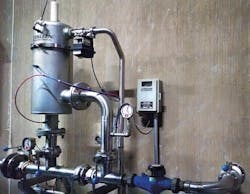Fast Filters
About the author:
Robin Brooks is content provider for Tekleen Automatic Filters Inc. Brooks can be reached at [email protected] or 310.829.2828.
Self-cleaning filters save time and money that is spent every day in the labor of cleaning and replacing irrigation heads, drippers, sprinklers, screens, bags and sand media tanks. Rinsing takes as few as 5 seconds, using as little as 4 gal of rinse water without interrupting the main flow.
The filters are used across the U.S. and worldwide to filter water for a number of purposes.
Golf Course Solution
At a golf course in Southern California, a water reservoir was located on a hill above the course. The problem that stood out was how to get filter rinse water back up the hill to the reservoir without using an expensive pumping system. Gideon Brunn, CEO of Tekleen, visited the golf course to assess the situation and offered expertise to solve the problem. The Tekleen system produces very little wastewater in the self-cleaning process, so it can flow out of the filters onto turf areas to supplement irrigation, instead of being pumped uphill to the reservoir. The wastewater drains out of the filters into a perforated barrel that slows the wastewater drainage onto the turf. Additional reasons for selecting the filters included their stainless steel construction, fewer moving parts and ease of maintenance.
Because of the filters, the golf course is able to run a drip irrigation system, which previously would not have been considered. Drip irrigation emitters are subject to the same clogging issues as spray heads. The system keeps drip irrigation systems cleaner, as well. In this case, with both types of irrigation systems, the water source and the type and size of debris determined the optimum filter mesh.
Brewery Garden & Landscaping
A well-known commercial brewery uses Tekleen filters in two locations in Southern California and western North Carolina. The brewery is known for water conservation in its beer processing operation, as well as in irrigating the organic visitor gardens used to grow food for the brewery restaurant and for irrigating the extensive facility landscaping. Water for these purposes is retrieved from reclaimed rainwater.
The brewery captures the rainwater through permeable paving, which creates a biobed, allowing rainwater to seep into the ground and into an underground cistern for storage. The cistern has a capacity of 460,000 gal that is used in the drip irrigation system. The filtering system for this application is model MTF3-L with a 50-µ filter. It prevents debris from accumulating in the drip system nozzles so there is a constant source of irrigation water available. Downtime and labor for nozzle cleaning is infrequent and minimized.
The Self Cleaning Process
Normal Filtering Operation
- Source water enters the inlet of the filter and passes through to a coarse screen.
- The coarse screen protects the fine screen from damage by any large particulates.
- Water moves through the coarse screen and down the center of the filter body through a fine screen that filters out suspended solids to a predetermined size.
- Clean water passes through the fine screen and out of the outlet of the filter, while particulates are trapped on the inside of the fine screen. This causes a pressure drop at the outlet, which initiates the self-cleaning cycle.
Backwash (Self-Cleaning) Cycle
- The backwash cycle is accomplished without interrupting the main flow. A signal is sent to an electronic controller, which opens a flush valve to start the backwash cycle.
- The dirt is aggressively vacuumed off of the screen by a suction nozzle.
- A dirt collector transfers the debris from the fine screen through the suction nozzles.
- A hydraulic motor causes the dirt collector to rotate axially and move linearly. This allows the dirt collector to scan 100% of the screen. The rinse water exits through the flush valve.
- A piston moves the dirt collector back to its original position at the end of the cleaning cycle.



